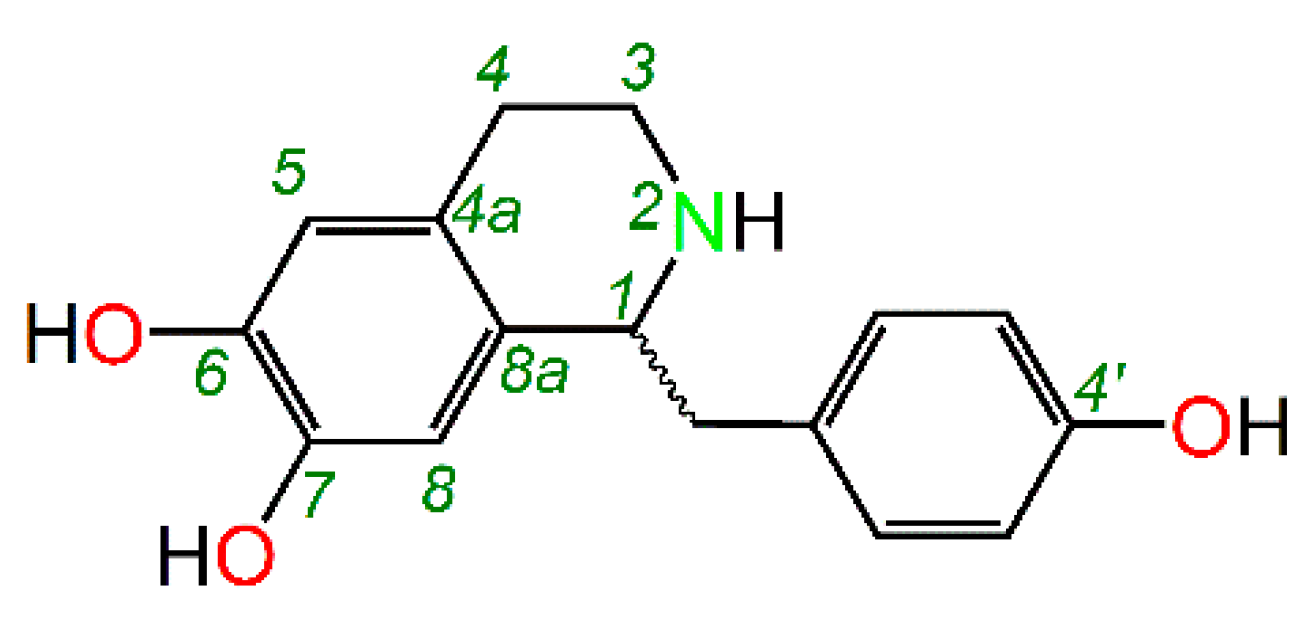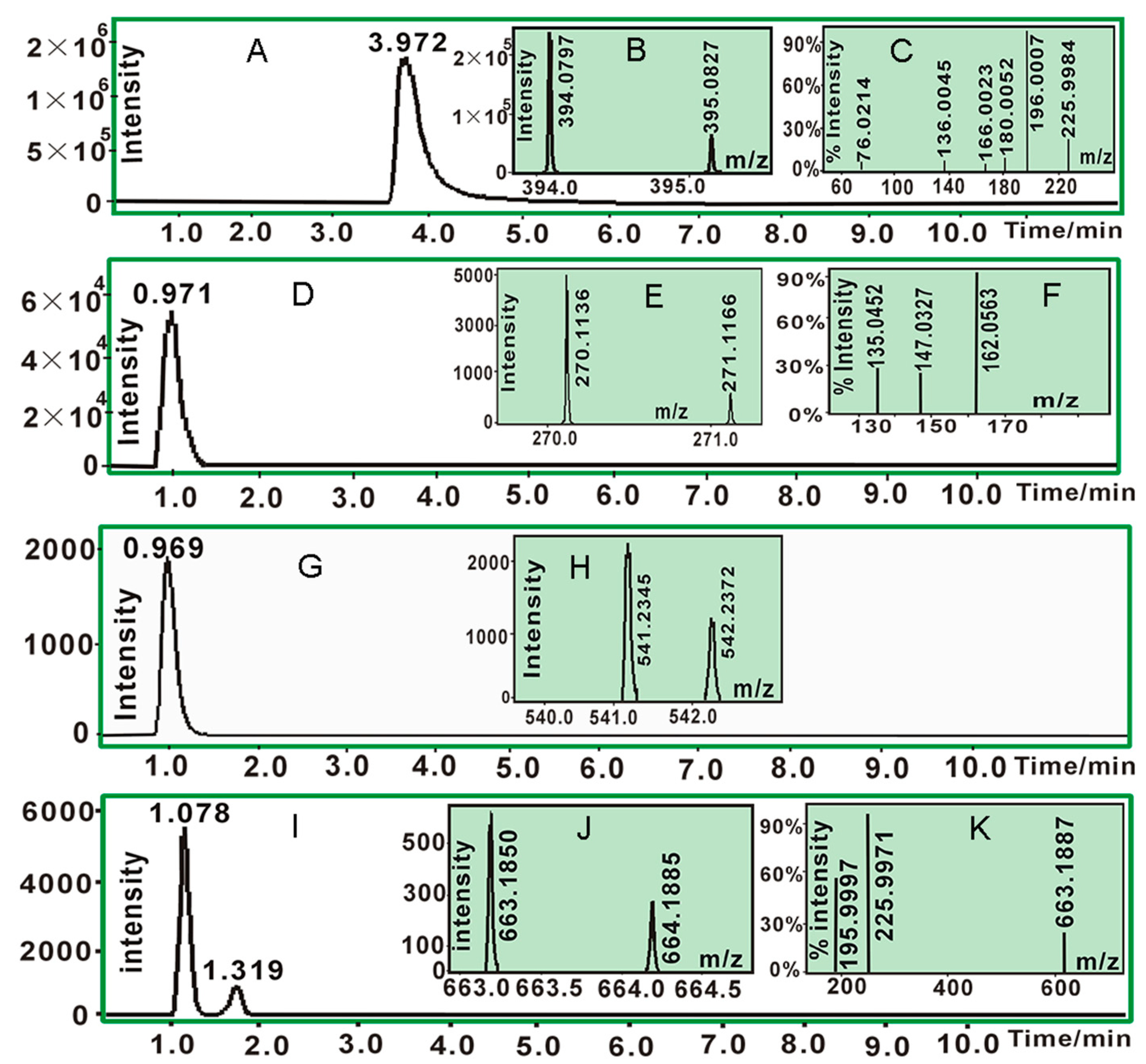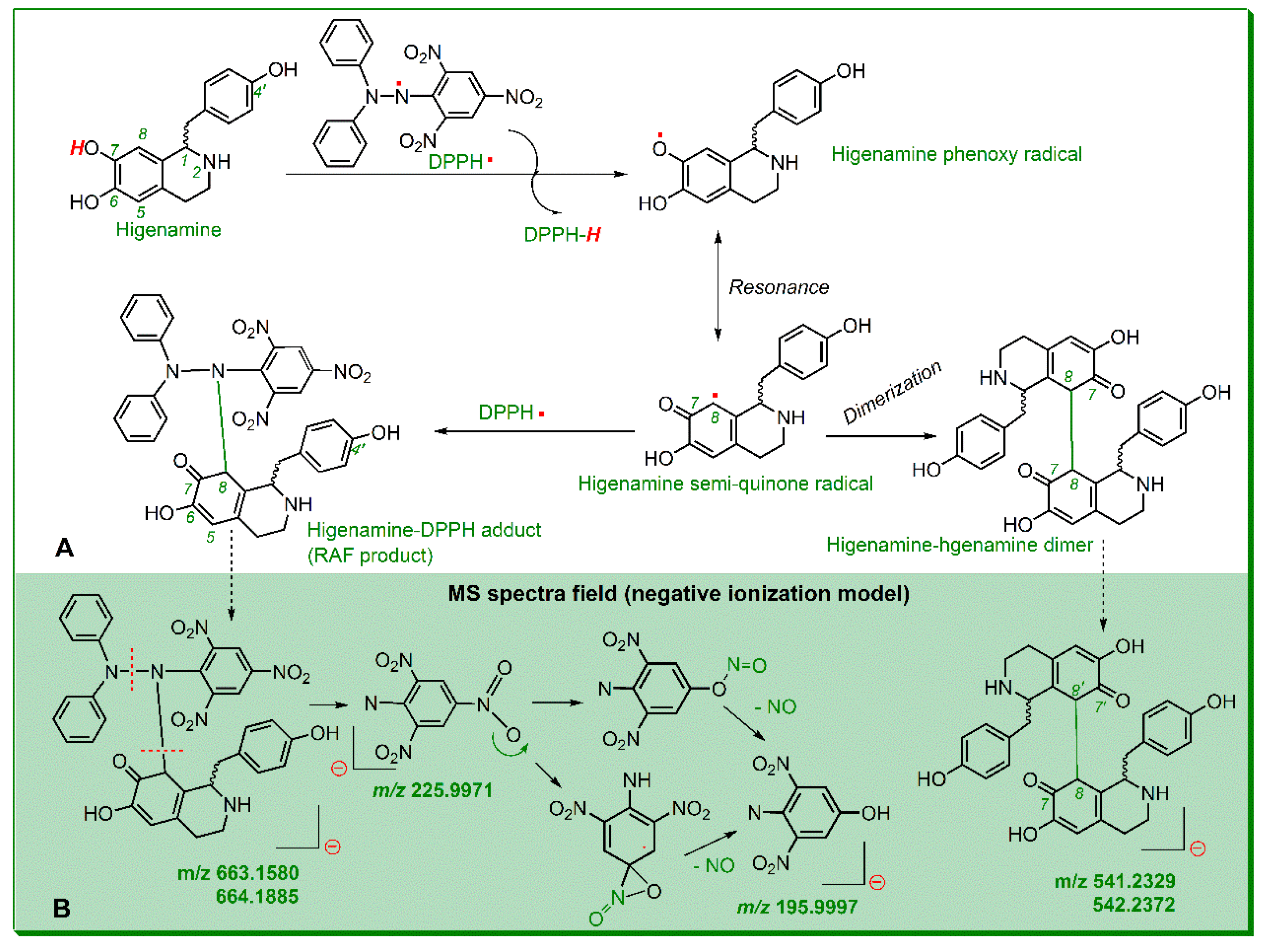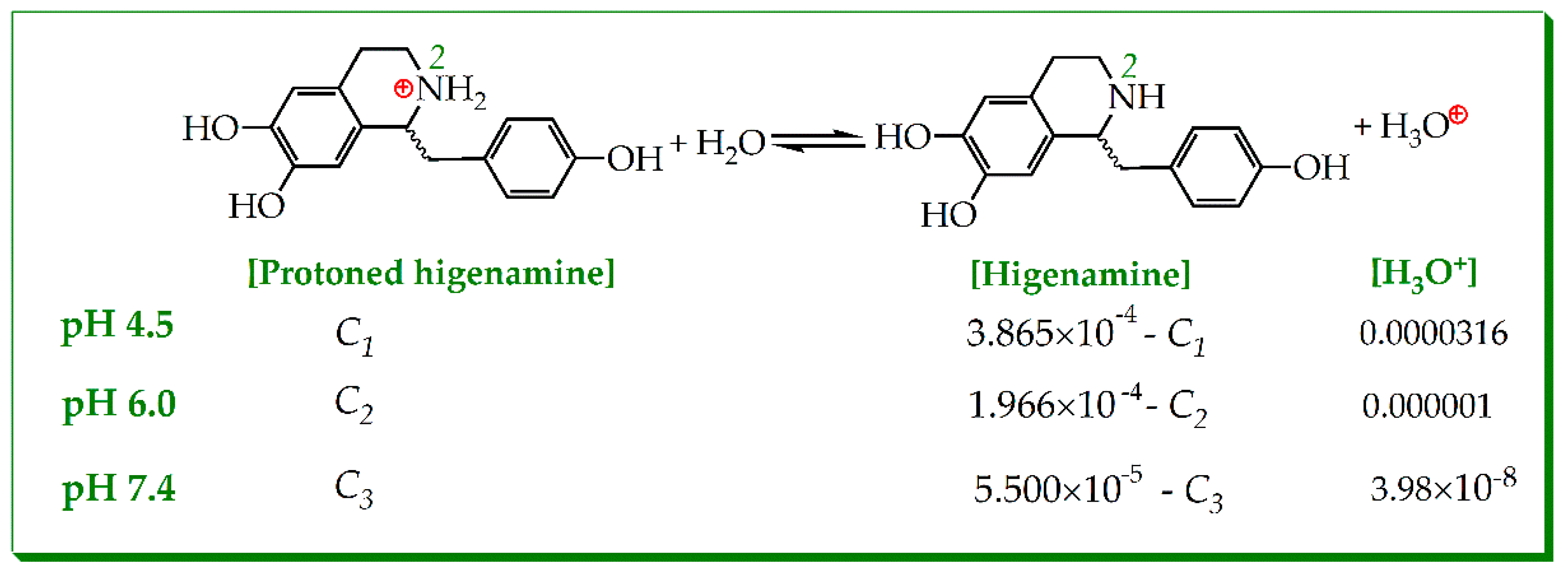pH Effect and Chemical Mechanisms of Antioxidant Higenamine
Abstract
:1. Introduction
2. Results and Discussion
3. Materials and Methods
3.1. Chemicals
3.2. DPPH•-Scavenging Assay (Methanol Solution)
3.3. UPLC-ESI-Q-TOF-MS/MS Analysis of DPPH• Reaction Products with Higenamine
3.4. pH Effect of Higenamine on PTIO•-Scavenging Ability
3.5. Ferric-Reducing Antioxidant Power (pH 3.6)
3.6. Cu2+-Reducing Assay (pH 7.4)
3.7. Statistical Analysis
4. Conclusions
Supplementary Materials
Author Contributions
Funding
Conflicts of Interest
Abbreviations
| ABTS | 2,2′-azinobis(3-ethylbenzthiazoline-6-sulfonic acid) |
| DPPH• | 1,1-diphenyl-2-picryl-hydrazl radical |
| ET | electron-transfer |
| HAT | hydrogen atom transfer |
| PT | proton-transfer |
| PTIO• | 2-phenyl-4,4,5,5-tetramethylimidazoline-1-oxyl 3-oxide radical |
| ROS | reactive oxygen species |
| RNS | reactive nitrogen species |
| RAF | radical-adduct-formation |
| SD | standard deviation |
| TPTZ | 2,4,6-tris(2-pyridyl-s-triazine) |
| Trolox | (±)-6-hydroxyl-2,5,7,8-tetramethlychromane-2-carboxylic acid |
References
- Abelskov, A.K.; Smith, A.T.; Rasmussen, C.B.; Dunford, H.B.; Welinder, K.G. pH dependence and structural interpretation of the reactions of Coprinus cinereus peroxidase with hydrogen peroxide, ferulic acid, and 2,2′-azinobis. Biochemistry 1997, 36, 9453–9463. [Google Scholar] [CrossRef] [PubMed]
- Li, X.C.; Jiang, Q.; Wang, T.T.; Liu, J.J.; Chen, D.F. Comparison of the antioxidant effects of quercitrin and isoquercitrin: Understanding the role of the 6′′-OH group. Molecules 2016, 21, 1246. [Google Scholar] [CrossRef] [PubMed]
- Li, X.C.; Chen, B.; Xie, H.; He, Y.H.; Zhong, D.W.; Chen, D.F. Antioxidant structure-activity relationship analysis of five dihydrochalcones. Molecules 2018, 23, 5. [Google Scholar] [CrossRef] [PubMed]
- Li, X.C.; Mai, W.Q.; Chen, D.F. Chemical study on protective effect against hydroxyl-induced DNA damage and antioxidant mechanism of myricitrin. J. Chin. Chem. Soc. 2014, 61, 383–391. [Google Scholar] [CrossRef]
- Qin, H.L.; Yu, D.Q. 1H-NMR Spectroscopic Databook of Natural Products-Alkaloid, 1st ed.; Chemical Industry Press: Beijing, China, 2011; pp. 8–1123. [Google Scholar]
- Li, X.C.; Lin, J.; Chen, B.; Xie, H.; Chen, D.F. Antioxidant and cytoprotective effects of kukoamines A and B: Comparison and positional isomeric effect. Molecules 2018, 23, 973. [Google Scholar] [CrossRef] [PubMed]
- Jiang, Q.; Li, X.C.; Tian, Y.G.; Lin, Q.; Xie, H.; Lu, W.B.; Chi, Y.G.; Chen, D.F. Lyophilized aqueous extracts of Mori fructus and Mori ramulus protect mesenchymal stem cells from •OH-treated damage: Bioassay and antioxidant mechanism. BMC Complement. Altern. Med. 2017, 17, 242. [Google Scholar] [CrossRef] [PubMed]
- Li, X.C.; Han, L.; Li, Y.R.; Zhang, J.; Chen, J.M.; Lu, W.B.; Zhao, X.J.; Lai, Y.T.; Chen, D.F.; Wei, G. Protective effect of sinapine against hydroxyl radical-induced damage to mesenchymal stem cells and possible mechanisms. Chem. Pharm. Bull. 2016, 64, 319–325. [Google Scholar] [CrossRef] [PubMed]
- Li, X.C.; Han, W.J.; Mai, W.Q.; Wang, L. Antioxidant activity and mechanism of Tetrahydroamentoflavone in vitro. Nat. Prod. Commun. 2013, 8, 787–789. [Google Scholar]
- Foti, M.C. Antioxidant properties of phenols. J. Pharm. Pharmacol. 2007, 59, 1673–1685. [Google Scholar] [CrossRef] [PubMed]
- Tang, C.; Amin, D.; Messersmith, P.B.; Anthony, J.E.; Prudhomme, R.K. Polymer directed self-assembly of pH-responsive antioxidant nanoparticles. Langmuir 2015, 31, 3612–3620. [Google Scholar] [CrossRef] [PubMed]
- Amorati, R.; Pedulli, G.F.; Cabrini, L.; Zambonin, L.; Landi, L. Solvent and pH effects on the antioxidant activity of caffeic and other phenolic acids. J. Agric. Food Chem. 2006, 54, 2932–2937. [Google Scholar] [CrossRef] [PubMed]
- Amorati, R.; Baschieri, A.; Morroni, G.; Gambino, R.; Valgimigli, L. Peroxyl radical reactions in water solution: A gym for proton-coupled electron-transfer theories. Chemistry 2016, 22, 7924–7934. [Google Scholar] [CrossRef] [PubMed]
- Anna, G.S.; Malgorzata, M. pH-Dependent radical scavenging activity of folates. J. Agric. Food Chem. 2007, 55, 8237–8242. [Google Scholar]
- Zhang, N.; Lian, Z.Q.; Peng, X.Y.; Li, Z.J.; Zhu, H.B. Applications of higenamine in pharmacology and medicine. J. Ethnopharmacol. 2017, 196, 242–252. [Google Scholar] [CrossRef] [PubMed]
- Zheng, R.L.; Huang, Z.Y. Free Radical Biology; Higher Education Press: Beijing, China, 2007; p. 143. [Google Scholar]
- Li, X.C.; Tian, Y.G.; Wang, T.T.; Lin, Q.Q.; Feng, X.Y.; Jiang, Q.; Liu, Y.M.; Chen, D.F. Role of the p-coumaroyl moiety in the antioxidant and cytoprotective effects of flavonoid glycosides: Comparison of astragalin and tiliroside. Molecules 2017, 22, 7. [Google Scholar] [CrossRef] [PubMed]
- Lee, Y.S.; Kang, Y.J.; Kim, H.J.; Park, M.K.; Seo, H.G.; Lee, J.H.; Yun-choi, H.S.H.; Chang, K.C. Higenamine reduces apoptotic cell death by induction of heme oxygenase-1 in rat myocardial ischemia-reperfusion injury. Apoptosis 2006, 11, 1091–1100. [Google Scholar] [CrossRef] [PubMed]
- Yang, Y.N.; Guo, Y.T.; Tan, X.Y.; He, H.B.; Zhang, Y.; Yin, T.; Xu, H.; Tang, X. Vincristine-loaded liposomes prepared by ion-paring techniques: Effect of lipid, pH and antioxidant on chemical stability. Eur. J. Pharm. Sci. 2018, 111, 104–112. [Google Scholar] [CrossRef] [PubMed]
- Clayden, J.; Greeves, N.; Warren, S. Organic Chemistry; Oxford University Press: New York, NY, USA, 2012; Volume 23, pp. 984–986. [Google Scholar]
- Xie, H.; Li, X.C.; Ren, Z.; Qiu, W.M.; Jiang, Q.; Chen, B.; Chen, D.F. Antioxidant and cytoprotective effects of Tibetan tea and its phenolic components. Molecules 2018, 23, 179. [Google Scholar] [CrossRef] [PubMed]
- Tian, Y.G.; Li, X.C.; Xie, H.; Wang, X.Z.; Xie, Y.L.; Chen, C.B.; Chen, D.F. Protective mechanism of the antioxidant baicalein toward hydroxyl radical-treated bone marrow-derived mesenchymal stem cells. Molecules 2018, 23, 223. [Google Scholar] [CrossRef] [PubMed]
- Samuni, A.; Goldstein, S.; Russo, A.; Mitchell, J.B.; Krishna, M.C.; Neta, P. Kinetics and mechanism of hydroxyl radical and OH-adduct radical reactions with nitroxides and with their hydroxylamines. J. Am. Chem. Soc. 2002, 124, 8719–8724. [Google Scholar] [CrossRef] [PubMed]
- Lucarini, M.; Pedulli, G.F. Free radical intermediates in the inhibition of the autoxidation reaction. Chem. Soc. Rev. 2010, 39, 2106–2119. [Google Scholar] [CrossRef] [PubMed]
- Fourré, I.; Florent, D.M.; Podloucká, P.; Otyepka, M.; Trouillas, P. Dimerization of quercetin, Diels-Alder vs. radical-coupling approach: A joint thermodynamics, kinetics, and topological study. J. Mol. Model. 2016, 22, 190. [Google Scholar] [CrossRef] [PubMed]
- Roche, M.; Dufour, C.; Mora, N.; Dangles, O. Antioxidant activity of olive phenols: Mechanistic investigation and characterization of oxidation products by mass spectrometry. Org. Biomol. Chem. 2005, 3, 423–430. [Google Scholar] [CrossRef] [PubMed]
- Brand-Williams, W.; Cuvelier, M.E.; Berset, C. Use of a free radical method to evaluate antioxidant activity. Lebensm-Wiss Technol. 1995, 28, 25–30. [Google Scholar] [CrossRef]
- Li, X.C.; Hu, Q.P.; Jiang, S.X.; Li, F.; Lin, J.; Han, L.; Hong, Y.L.; Lu, W.B.; Gao, Y.X.; Chen, D.F. Flos Chrysanthemi indici protects against hydroxyl-induced damages to DNA and MSCs via antioxidant mechanism. J. Saudi Chem. Soc. 2015, 19, 454–460. [Google Scholar] [CrossRef]
- Foti, M.C.; Daquino, C.; Mackie, I.D.; Dilabio, G.A.; Ingold, K.U. Reaction of phenols with the 2,2-diphenyl-1-picrylhydrazyl radical. Kinetics and DFT calculations applied to determine ArO-H bond dissociation enthalpies and reaction mechanism. J. Org. Chem. 2008, 73, 9270–9282. [Google Scholar] [CrossRef] [PubMed]
- Lopez-Munguia, A.; Hernandez-Romero, Y.; Pedraza-Chaverri, T.; Miranda-Molina, A.; Regla, L.; Martinez, A.; Castillo, E. Phenylpropanoid glycoside analogues: Enzymatic synthesis, antioxidant activity and theoretical study of their free radical scavenger mechanism. PLoS ONE 2011, 6, e20115. [Google Scholar] [CrossRef] [PubMed]
- Zhang, H.Y.; Wu, W.; Mo, Y.R. Study of proton-coupled electron transfer (PCET) with four explicit diabatic states at the ab initio level. Comput. Theor. Chem. 2017, 1116, 50–58. [Google Scholar] [CrossRef]
- Goldstein, S.; Russo, A.; Samuni, A. Reactions of PTIO• and carboxy-PTIO• with •NO, •NO2, and •O2−. J. Biol. Chem. 2003, 278, 50949–50955. [Google Scholar] [CrossRef] [PubMed]
- Li, X.C. 2-phenyl-4,4,5,5-tetramethylimidazoline-1-oxyl 3-oxide (PTIO•) radical-scavenging: A new and simple antioxidant assay in vitro. J. Agric. Food Chem. 2017, 65, 6288–6297. [Google Scholar] [CrossRef] [PubMed]
- Gulcin, I. Antioxidant activity of food constituents: An overview. Arch. Toxicol. 2012, 86, 345–391. [Google Scholar] [CrossRef] [PubMed]
- Benzie, I.F.; Strain, J.J. The ferric reducing ability of plasma (FRAP) as a measure of “antioxidant power”: The FRAP assay. Anal. Biochem. 1996, 239, 70–76. [Google Scholar] [CrossRef] [PubMed]
- Huang, D.; Ou, B.; Prior, R.L. The chemistry behind antioxidant capacity assays. J. Agric. Food Chem. 2005, 53, 1841–1856. [Google Scholar] [CrossRef] [PubMed]
- Greenleaf, W.B.; Silverman, D.N. Activation of the proton transfer pathway in catalysis by iron superoxide dismutase. J. Biol. Chem. 2002, 277, 49282–49286. [Google Scholar] [CrossRef] [PubMed]
- Li, X.C.; Li, K.; Xie, H.; Xie, Y.L.; Li, Y.Y.; Zhao, X.J.; Jiang, X.H.; Chen, D.F. Antioxidant and cytoprotective effects of the di-O-caffeoylquinic acid family: The mechanism, structure-activity relationship, and conformational effect. Molecules 2018, 23, 222. [Google Scholar] [CrossRef] [PubMed]
- Grunewald, G.L.; Seim, M.R.; Lu, T.; Makboul, M.; Criscione, K.R. Application of the Goldilocks effect to the design of potent and selective inhibitors of phenylethanolamine N-methyltransferase: Balancing pKa and steric effects in the optimization of 3-methyl-1,2,3,4-tetrahydroisoquinoline inhibitors by β-fluorination. J. Med. Chem. 2006, 49, 2939–2952. [Google Scholar] [CrossRef] [PubMed]
- Labrinea, E.P.; Georgiou, C.A. Stopped-flow method for assessment of pH and timing effect on the ABTS total antioxidant capacity assay. Anal. Chim. Acta 2004, 526, 63–68. [Google Scholar] [CrossRef]
Sample Availability: Sample of higenamine is available from the authors. |






| Assay | Higenamine μM | Trolox μM | IC50,Trolox/IC50,higenamine | |
|---|---|---|---|---|
| DPPH•-scavenging assay | 17.1 ± 0.2 a | 23.3 ± 0.3 b | 1.4 | Average 1.9 |
| PTIO•-scavenging assay (pH 7.4) | 55.0 ± 1.7 a | 81.0 ± 5.6 b | 1.5 | |
| Fe3+-reducing power assay | 30.0 ± 0.3 a | 63.1 ± 8.0 b | 2.1 | |
| Cu2+-reducing power assay | 57.0 ± 1.0 a | 154.8 ± 2.0 b | 2.7 |
© 2018 by the authors. Licensee MDPI, Basel, Switzerland. This article is an open access article distributed under the terms and conditions of the Creative Commons Attribution (CC BY) license (http://creativecommons.org/licenses/by/4.0/).
Share and Cite
Xie, Y.; Li, X.; Chen, J.; Deng, Y.; Lu, W.; Chen, D. pH Effect and Chemical Mechanisms of Antioxidant Higenamine. Molecules 2018, 23, 2176. https://doi.org/10.3390/molecules23092176
Xie Y, Li X, Chen J, Deng Y, Lu W, Chen D. pH Effect and Chemical Mechanisms of Antioxidant Higenamine. Molecules. 2018; 23(9):2176. https://doi.org/10.3390/molecules23092176
Chicago/Turabian StyleXie, Yulu, Xican Li, Jingyu Chen, Yuman Deng, Wenbiao Lu, and Dongfeng Chen. 2018. "pH Effect and Chemical Mechanisms of Antioxidant Higenamine" Molecules 23, no. 9: 2176. https://doi.org/10.3390/molecules23092176





